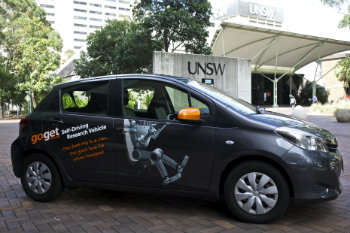Researchers at UNSW Australia have taken the first step towards creating a self-driving car by fitting sensors and other technology to a vehicle owned by car sharing service GoGet.
The car, which is based at UNSW's Kensington campus in Sydney, has four radar sensors, a video camera and a small on-board computer. It was publicly launched at the GeoNext technology conference held at Australian Technology Park in Sydney.
.

"We've put sensors all around the vehicle and mounted a video camera to detect pedestrians, bicycles, other cars and roadside infrastructure," rCITI's deputy director Vinayak Dixit explains.
"We're getting information about how people drive and how they interact with different moving entities as well as other infrastructure. This information is extremely useful when you're trying to develop algorithms for autonomous driving."
The project is an industry partnership between the UNSW Research Centre for Integrated Transport Innovation (rCITI) and GoGet. rCITI, which focuses on integrated transport research and development, secured a grant from the UNSW School of Civil and Environmental Engineering to buy the technology systems fitted to the vehicle.
GoGet's co-founders Nic Lowe and Bruce Jeffreys “are excited by technology and new ideas," Dixit says.
In addition to powering research on self-driving cars, Dixit also sees an opportunity to use the data collected by the sensors to explore the feasibility of real-time charging schemes for car insurance.
"What we really want to move towards is real-time insurance, where the driver's rates depend on how they drive at that moment," Dixit explains.


